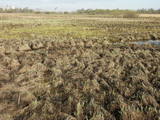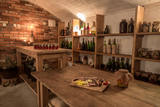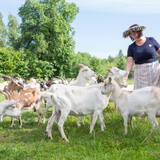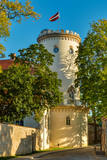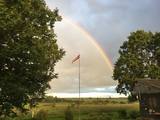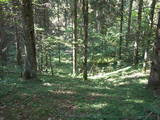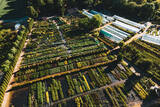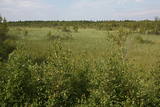| Nr | Nosaukums | Apraksts |
|---|---|---|
|
Zemnieku saimniecības laukos ganās vairāk nekā pusotrs simts aitu. Uzcelta teķu nobarošanas stacija, tiek organizētas dzīvnieku izsoles un Aitu dienas. Saimnieks vada ekskursijas, piedāvā šķirnes aitu un aitkopības produkcijas iegādi. |
||
|
Izcila lokveida taka (4,5 km), kuras lielākā daļa (koka laipas) ved pa Rīsas purvu (Riisa raba). No takas un divstāvīgā koka skatu torņa ir vērojami purva ezeriņi, lāmas, un purvaini meži. Ja nacionālā parka apskati sāk no ziemeļu puses, tad šī taka ir labs ceļojuma iesākums! |
||
|
Silajāņu podniecības tradīciju uzturētājs. Darbnīcā top glazētie un neglazētie izstrādājumi – trauki, svečturi u.c. Apmeklētājiem atraktīvā veidā pastāstīs par podnieka darbu, ļaus pamīcīt mālus un darboties ar virpu. Izveidota ekspozīcijas zāle ar gadu laikā tapušajiem darbu paraugiem. Izstrādājumu pasūtīšana un iegāde. |
||
|
Jelgavas novada saimniecībā "Blūdži" mājražotāji Mālkalnu ģimene piedāvā degustēt un iegādāties pašu gatavotu svaigo, kūpināto, vai marinēto sieru. Produkciju var iegādāties arī Vidzemes tirgū - trešdienās. Saimniecībā uzņem tūristu grupas. Saimniecībā cep maizi, pārstrādā dārzeņus - gatavo dārzeņu salātus un konservējumus un gatavo citus lauku labumus. |
||
|
Dabiskās palieņu pļavas, kas atrodas Lielupes krastos pirms un iepretim Jelgavai (liegumam divas daļas), ir daudzu nozīmīgu aizsargājamu augu sugu dzīves un putnu ligzdošanas un atpūtas vieta migrāciju laikā. Pļavu apsaimniekošanas nolūkos tajās ir izlaisti dzīvei savvaļā pielāgotie mājlopi. Nākotnē plānots arī putnu vērošanas tornis.
|
||
|
Medinsku Vincīšu akmens. Vietējie iedzīvotāji pakalnu, uz kura atrodas dižakmens, sauc par
Magoņkalnu. Medinsku Vincīšu akmens atrodas koku pudurī tikai 40 m pa kreisi no Jaunviļānu –
Medinsku ceļa un aptuveni 40 m no Maltas upes labā krasta. Sarkanā rapakivi granīta akmens izmēri: garums
6,6 m, platums 5,4 m , augstums 3,3 m, apkārtmērs 20 m, tilpums 40 – 45 kubikmetri.
|
||
|
To start the tour you take a train from Riga to Liepaja, a city with white sandy beaches and a lively cafe culture. The route goes through suburbs of Liepaja to the former millitary town where you see the Orthodox cathederal, old naval fortifications, former barracks and an imposing military prison which is now a tourism site. Pavilosta is a small seaside town and a favourite with windsurfers. Next the route follows the picturesque coastline, including steep banks at Jurkalne and finishes at the well-maintained town of Ventspils. Then along to fishing villages that are home to the tiny Finno-Ugric ethnic group, the Livs. At Cape Kolka the Baltic Sea meets the Gulf of Riga. Here, sampling the local smoked fish is a must. Further on, the route crosses three different types of sea shore – the stony beach at Kaltene, a sandy one at Upesgriva and coastal meadows at Engure. Finish with the trails at Kemeri National Park and return to Riga from the popular resort town of Jūrmala. |
||
|
Viesi tiek aicināti apmeklēt viesu nama tradicionālo lietuviešu etnogrāfisko pagrabu. Šeit piedāvā degustēt sālīto speķi ar skābētiem ekoloģiskajiem gurķiem, nogaršot mājas sieru ar dažādiem dabīgajiem ievārījumiem, nogaršot viesu nama saimnieku gatavoto ābolu vai vīnogu vīnu. Tāpat viesi tiek cienāti ar šeit gatavoto irbeņu tēju. |
||
|
Vieta, bez kuras apmeklējuma nav iedomājama Dzūkijas vēstures un kultūras izziņa! Muzejs meklējams Marcinkones centrā, netālu no dzelzceļa stacijas. To noteikti ir jāiepazīst vietējā gida pavadībā, kas pastāstīs daudz interesantus faktus par dzūku tradīcijām un attiecībām ar mežu. Muzejā ir apskatāma dzīvojamā ēka ar ikdienas sadzīves priekšmetiem un rija, kas pārsteidz ne tikai ar savu plašumu, bet arī vairākiem interesantiem eksponātiem, no kuriem ir jāpiemin milzīgs sēņu grozs (tajā iegāja 110 kg gaileņu!), 750 gadus veca vienkoča paliekas, bitenieku un vietējo amatnieku instrumenti u.c. Rijā notiek ikgadēji ar dzūku kultūru un vēsturi saistīti pasākumi. Visbeidzot, te var iegādāties vietējos suvenīrus un medu. Ja ir vēlme iepazīt Marcinkones tuvāko apkaimi, ar kājām var doties pa 13 km garo Zackagira dabas taku (Zackagirio gamtinis takas). |
||
|
Latviska lauku sēta, kurā ganās ap 100 kazas un kur piedāvā ekskursijas pa saimniecību. Var nogaršot un iegādāties mājās gatavotu plombīra saldējumu no kazas piena un dažādus sierus. Iespēja arī baudīt uz ugunskura gatavotu zupu. Saimniecībā ir arī lauku pirts ar lielu pirts lāvu līdz 8 personām. |
||
|
Kaut arī Cēsis ģeogrāfiski atrodas Gaujas nacionālā parka vidienē, pilsētai nav nacionālā parka statusa. Taču Cēsīs ir daudzi interesanti apskates objekti, kurus ir vērts redzēt un izzināt tuvāk. Noteikti ir jāiepazīst Cēsu vecpilsēta! Cēsu pirmsākumi ir meklējami 18 m augstajā Riekstu kalnā un tā tuvākajā apkārtnē, jo 11. – 13. gs. te atradās vendu no koka celtā pils. Riekstu kalns meklējams Pils parka vidusdaļā, un no tā paveras labs skats uz Pils parku, dīķi un Cēsu pilsdrupām, līdz kurām var nokļūt pa garu kāpņu kaskādi. 13. gs. sākumā celtā Cēsu pils (aprakstu sk. tālāk pie Nr. 44.) bija ordeņa mestru rezidence un viens no stiprākajiem ordeņa cietokšņiem tagadējās Baltijas teritorijā. Tai blakus atrodas Cēsu Jaunā pils, kas celta 1777. g. vārtu nocietinājumu vietā. Ēkā ir iekārtots Cēsu Vēstures un mākslas muzejs, bet piebūvē mājvietu atradis Pils kompleksa apmeklētāju centrs un Cēsu tūrisma informācijas centrs. Ja uzkāpsim pils tornī, no tā pavērsies labs skats uz pilsdrupām, Sv. Jāņa luterāņu baznīcu un pilsētas ziemeļdaļu. Iepretim Cēsu Jaunai pilij atrodas vairākas ēkas – Cēsu pilsmuižas stallis un ratnīca (abas ēkas celtas 19. gs. pirmajā pusē), kur mūsdienās meklējams Cēsu Izstāžu nams. Pils kompleksa teritorijā no ārpuses ir apskatāma arī klēts, kučieru namiņš un vecā alus darītava. Ielas pretējā pusē atrodas romantiskais Maija parks, kurš iekārots 19. gs. trīsdesmitajos gados. To iecienījuši vecāki ar bērniem, jo te izveidots rotaļlaukums. Dosimies tālāk pilsētas ielās (Lielās Katrīnas, Mazās Katrīnas, Mazā Kalēju, Kalēju, Lielā Līvu iela un Līvu laukums) un apskatīsim 18. – 19. gs. mijā tapušo koka apbūvi. Torņa ielā, kas vijas gar Viduslaiku pils aizsargmūri, pie baznīcas apskatāma M. Jansona skulptūra „Gadsimtiem ejot". Ticējums vēsta, ka paberzējot Laika veča lukturi, ir iespējams redzēt nākotni. Viena no iespaidīgākajām Cēsu celtnēm ir Sv. Jāņa luterāņu baznīca, kas būvēta 13. gs. beigās kā Livonijas ordeņa Doms. Tā ir romānikas stila trīsjomu bazilika ar gotikas elementiem ar 1853. g. celto 65 m augsto torni. Ēka vairākkārt ir pārbūvēta arī 20. gs. Dievnamā apskatāmas Livonijas ordeņa mestru un Livonijas bīskapu kapa plāksnes. Kancele taisīta 1748. g., ozolkoka altāris - 1858. g., bet altārgleznu "Krustā sistais" - 1862. g. Baznīcas altārdaļas logus rotā mākslinieciski vērtīgas vitrāžas. Ērģeles 1907. g. darinājusi E. F. Valkera firma, un tās ir vienas no labākajām Latvijas koncertērģelēm. Dievnama dienvidrietumu stūra atbalstā iemūrēts saules pulkstenis ar gada skaitli "1744". Ir vērts uzkāpt baznīcas skatu tornī. Baznīcas pakājē atrodas Rožu laukums jeb bijušais Tirgus laukums (13. gs. vidus – 1927. g, atjaunots 2008. g), kas mūsdienās ir pilsētas centrālais laukums. Viduslaikos šeit ir atradies arī soda stabs un pilsētas aka. Rīgas iela no pilsētas pirmsākumiem veidojusies par galveno vecpilsētas ielu. Šeit aplūkojams vairākums Cēsu arhitektoniski izcilāko 18. -19. gs. celtņu – bijušais Cēsu rātsnams, Fābera nams, Princešu nams. Vienā ielas galā atrodas Līvu laukums, kur 13. gs. atradās baznīca, kapsēta un Rīgas vārti pilsētas mūrī. Šodien laukumu rotā izgaismota strūklaka, kuras vietā 13. gs. atradusies aka - Lejas Šķimbēgs. Otrā ielas galā atrodas 14. - 15. gs. pilsētas mūra Raunas vārtu pamatu un virszemes fragmentu rekonstruētā daļa. Tā rada labu priekšstatu par viduslaiku mūri, vārtu lielumu un pamatīgumu. |
||
|
"Bielēs" saimnieko jauna ģimene, kas Rīgas steigu ir nomainījusi pret lauku mieru, vēlas atjaunot pazaudēto saikni ar Zemi, iemācīties saklausīt un sajust gadalaikus, kā arī izveidot pašpietiekamu saimniecību. Saimniekiem patīk viss, kas ir dabisks un varbūt pat nedaudz netradicionāls. Patīk eksperimentēt un nepatīk pilsētas stīvums. |
||
|
Krievkalnu augstākajā punktā (149 m v.j.l.) ir izveidota labiekārtota atpūtas vieta, no kuras paveras iespaidīgs skats austrumu virzienā.
|
||
|
Zemnieku saimniecība „Lejas Kleperi” atrodas Smiltenes novadā. Saimniecības zemes kopplatība ir 119,4ha t.sk. meži 86,1ha. Saimniecības pamatnodarbošanās saistīta ar meža apsaimniekošanu. Kopš 1992. gada vienā no dzīvojamām ēkām uzsākta zemkopības un mežkopības instrumentu privāta muzeja veidošana. Muzeja eksponātu klāsts tiek nemitīgi papildināts. |
||
|
Bejas meža dabas liegums veidots no reljefa viedokļa - interesantā, pauguru un starppauguru ieplaku saposmotā teritorijā, kuru klāj vecs un varens egļu mežs. Bejas mežā atrodas viena no Alūksnes rajonā vairākām "Velna pēdēm" - dziļa, krāterveida ieplaka, ko veidojis kūstošais ledājs.
|
||
|
Profesionāla lauksaimniecības tūre, kuras laikā tiek iepazītas Latvijas modernākās graudaugu ražošanas saimniecības, kas raksturīgas Zemgales reģionam. Iepazīšanās diena, kuras laikā organizēta tikšanās ar Latvijas Republikas Zemkopības ministrijas speciālistiem, lauksaimnieku NVO pārstāvjiem. Latvijas galvaspilsētas – Rīgas (UNESCO mantojums), Rīgas centrālā tirgus (viens no lielākajiem slēgtā tipa tirgiem Eiropā) apskate. Veselīgas pārtikas veikala apmeklējums. Vakariņas ar latviešu tradicionālo ēdienu un alus šķirņu baudīšanu. Nākamajā dienā dodamies uz Jelgavu, kur 18.gs. celtā Kurzemes un Zemgales hercogistes pilī organizēta tikšanās ar Latvijas Lauksaimniecības universitātes mācībspēkiem. Maiznīcas, kurā cep maizi no bioloģiskā veidā audzētiem produktiem – apmeklējums. Nākamā ir saimniecība, kurā apvienota augkopība ar lopkopību un biogāzes ražošanu. Tajā izveidots mākslīgs mitrājs, kas attīra notekūdeņus. Vakariņas modernā un mūsdienīgā atpūtas kompleksā. Nākamajā dienā dodamies uz vienu no lielākajām Zemgales daudznozaru saimniecībām, kas specializējusies, augkopības, lopkopības, zirkopības, biogāzes un alus ražošanas jomās. Pēc tam – lielākās un tehnoloģiski modernākās graudkopības saimniecības apmeklējums. Pēcpusdienā – ekskursija pa Baltijā izcilāko pili – Rundāles pili. Tā celta kā Kurzemes hercoga Ernsta Johana Bīrona vasaras rezidence, kas būvēta pēc ievērojamā itāļu arhitekta F. B. Rastrelli projekta. Vakariņas ēdam kompleksā, kurā ietilpst vēsturiskas vējdzirnavas ar graudkopības tēmai veltītu ekspozīciju. Ceturtās dienas rītā – graudkopības saimniecības apmeklējums, kas audzē sēklas. Pēc tam – bioloģiskās saimniecības apmeklējums, kas audzē kviešus, miežus, zirņus, pupas, rapsi, garšvielas un zāļu tējas. Piedāvā pusdienas lauku sētā, kas gatavotas no pašu izaudzētiem graudiem un rupja maluma miltiem. Atgriešanās Rīgā. |
||
|
Produktu izgatavošana no ārstniecības augiem - tējas, sīrupi, augu pulveri, ziedes. Pakalpojumu piedāvājums - ekskursijas, radošās darbnīcas, meistarklases, pirts. |
||
|
Kafejnīca „Sprīdīši” atrodas rakstnieces Annas Brigaderes muzeja pagrabiņā, Tērvetes upītes krastā. Vasarās ēdienu var izbaudīt uz ārā terases. Piedāvā ballītes kopā ar Tērvetes meža labajām raganiņām un vizināšanos zirga pajūgā (vasarās) vai kamanās (sniegotās ziemās). Latviešu virtuve: Cūkgaļas ribiņas medus mērcē, pankūkas ar ievārījumu, sēņu mērce. Īpašais ēdiens: „Lāča ķepa”. |
||
|
Viena no bagātākajām un ainaviski skaistākajām Latvijas kokaudzētavām. Tās piedāvājumā ir ~ 1000 dažādu kokaugu sugu, šķirņu un formu. Spēcīga ražošanas bāze. Moderns aprīkojums- trīs podojamās mašīnas, laistīšanas sistēmas, augu transports, liela izmēra koku rakšanas tehnika, liela siltumnīcu saimniecība utt. |
||
|
Lai apskatītu purvu, tajā nav jābrien iekšā. Platenes purvu lieliski var pārlūkot no Ventspils Rīgas ceļa (starp 77. km stabiņu un autobusa pieturu „Pagrieziens uz Elkšķeni”), kur paveras tāls un plašs skats. Dabas lieguma nozīmīgākā aizsargājamā vērtība – kaļķains zāļu purvs ar rūsgano melnceri, kas ir šī biotopa lielāka atradne Latvijā. Uzmanīgi un valsts nozīmes autoceļa – apstājieties tikai atļautā vietā, netraucējot satiksmi! Dažus kilometrus Rīgas virzienā autoceļa malā uz Grīžu Velna krēslu, kas ir interesants dižakmens (aizsargājams).
|
||





